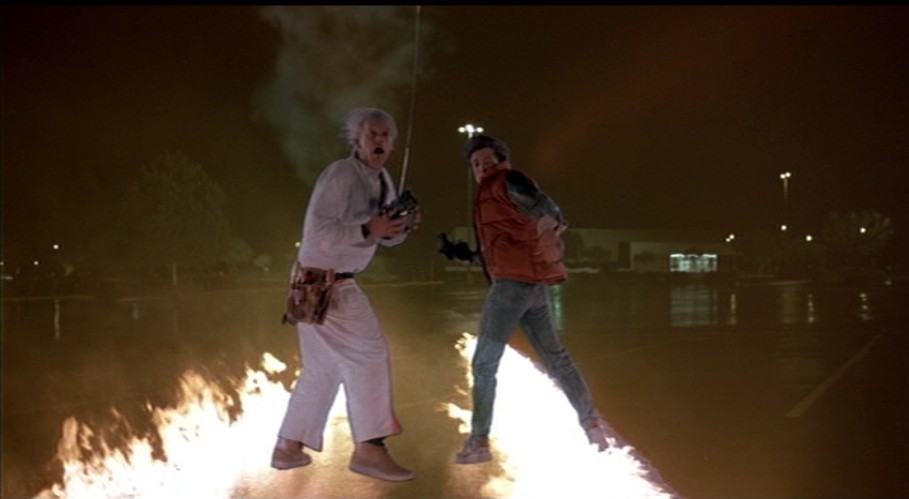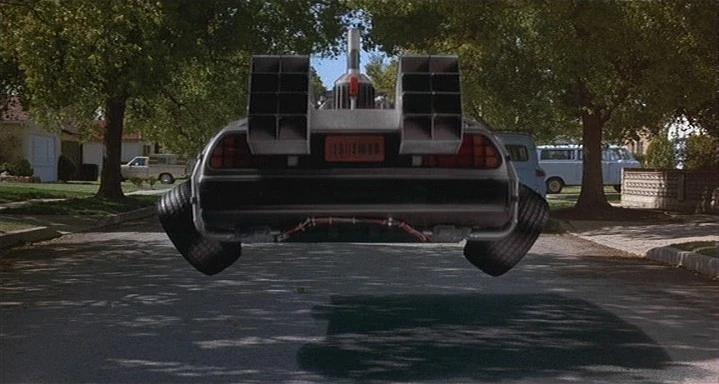On July 3rd, 1985, Robert Zemeckis’ BACK TO THE FUTURE left a trail of fire, zooming into American multiplexes and ending up the number one movie of the year, launching a successful franchise that included not only two more movies but also several video games and an animated series. It’s funny, it’s got a love story, and can even be a little scary at times. The film spent eight weeks at number one and became the highest grossest film of 1985. Growing up, I had two VHS tapes that a friend of my mom’s made me off of HBO (the Vanderbilts did not get cable until 1988). Over two cassettes recorded in EP format, I had GREMLINS, SHORT CIRCUIT, TEEN WOLF, GHOSTBUSTERS, THE LAST STARFIGHTER, and BACK TO THE FUTURE at my disposal. Needless to say, all six films became burned into my memory like the tracks of a time-traveling DeLorean.
BACK TO THE FUTURE, it would appear, became an was an instant classic: lauded by critics and audiences alike. I wanted to be Marty McFly and the film inspired me to buy my first denim jacket and pick up my first pair of high-top Chuck Taylors. In my teenage years, I picked up a guitar and routinely told my band that it was a “standard blues riff in B,” even if it was not. Aside from being ridiculously quotable, BACK TO THE FUTURE is the best kind of science fiction: like so many of the best Ray Bradbury stories or Twilight Zone episodes, the film used sci-fi and fantasy as a MacGuffin to tell a simple, very human story.. At its heart, BACK TO THE FUTURE is a romantic comedy steeped in Robert Zemeckis’ cynicism and sci-fi special effects; a crunchy exterior with a very sweet center.

That crunchy exterior is quintessential Robert Zemeckis; while he definitely owes quite a bit to the Amblin camp, Zemeckis comes off as a more cynical Spielberg. On its surface, BACK TO THE FUTURE is a family film: a PG time-travel fantasy about falling in love, and riffing on the Boomer-inspired, nostalgia-sploitation of the era by taking a trip back to the ’50s. It’s a movie even Ronald Reagan (the actor) could love. There’s your sweet center, but that hard exterior reveals the film’s gallows humor. BACK TO THE FUTURE is definitely the funniest movie with incestuous overtones to come out of the ‘80s (FLOWERS IN THE ATTIC doesn’t hold a candle), but it’s Zemeckis’s knowing, light touch that makes it enjoyable…and not creepy. Marty’s main conflict in the movie is that his mother has the hots for him and he needs to set her up with his own father, who is now the same age as him. Kind of gives a new perspective on the term, “family film.”

BACK TO THE FUTURE is a relatively low-stakes story — Marty McFly is simply attempting to make his parents fall in love so that he is conceived…eventually. The fate of the world as we know it isn’t in danger of being destroyed, just Marty McFly’s world, and at the end of it all, it’s not the power of a Starfleet or a superhero that wins the day, it’s the power of love that provides one of the film’s many climaxes. As Lea Thompson said in a 2005 interview, “If you just stand up for yourself in that one important moment of your life, you can change everything.”

. ‘Fifties (and ‘sixties) nostalgia had been at an all-time high during the ‘70s, with not only the release of AMERICAN GRAFFITI, but subsequently Happy Days, Laverne & Shirley, and lest we forget, the musical stylings of Sha Na Na. BACK TO THE FUTURE combined modern 1985 cool for the youngsters with a nostalgic–if slightly cynical—look at 1955 that would appeal to older audiences looking to be whisked away back to their youth without having to kick a DeLorean up to 88 miles per hour. The screenplay perfectly appeals to audiences of all ages: if you’re too young for one joke, you may be too old for the next. The pacing makes sure that there’s not enough time in between to get bored.

Marty McFly is played to perfection by Michael J. Fox. While Eric Stoltz was originally cast in the role, he was considered “too intense.” Robert Zemeckis noted after seeing the dallies with Stoltz as the lead that he “wasn’t getting the laughs.” A deal was eventually reached, and Fox was put into the role. There were even a fair amount of scenes where Michael J. Fox didn’t even see his fellow actors’ performances as he was simply shooting coverage for scenes that Stoltz already shot. Fox didn’t even see the full scenes until the film premiered. Fox has an intangible charm as Marty McFly– he doesn’t play Marty as a stereotypical 1980s cool guy so much as he plays Marty as a dork who really thinks he’s cool; maybe it’s because he travels by skateboard or plays guitar in a loud garage rock band or perhaps because he has a cute girlfriend (played by Claudia Wells). The difference between Fox as Marty or any other teen heartthrob in the 1980s is that audiences, particularly those of the male persuasion can project themselves into the role easily. That dorky cool-guy charm is also a factor in the music of Huey Lewis, which provides a pitch-perfect, pop-rock score to the BACK TO THE FUTURE universe.

Huey Lewis And The News feel like the Marty McFly of 80’s rock: kind of dorky but at the same time undeniably cool. They combined their love of ‘fifties-era doo-wop with blue-eyed soul and ‘eighties new-wavey power pop. “The Power Of Love” was the band’s first number-one hit on the U.S. Billboard Hot 100 and was nominated for an Academy Award for Best Original Song. The band wrote two more songs for inclusion on the BACK TO THE FUTURE soundtrack, “Back In Time” and “Nick Of Time.” “Nick Of Time” wasn’t used in the film but was later featured in BREWSTER’S MILLIONS as performed by Patti LaBelle. (Perhaps in an alternate timeline, “Nick Of Time” was used in BACK TO THE FUTURE and Huey Lewis wound up backing Elvis Costello with Clover.)
The soundtrack also featured era-appropriate classics such “The Wallflower (Dance With Me, Henry)” and “Earth Angel” representing 1955, and Eric Clapton’s “Heaven Is One Step Away” and Lindsey Buckingham’s “Time Bomb Town” representing 1985. Frequent Zemeckis collaborator Alan Silvestri’s score is relatively minimal—he actually composed new music not featured in the film for a recent public performance of the score—but his main theme is as memorable from the Spielberg-Lucas-Williams trifecta that dominated sci-fi and fantasy in the 1980s. It’s big and exciting, just like the film’s numerous climaxes.
BACK TO THE FUTURE rewards viewers for paying attention and is chock full of Easter eggs, before Easter eggs were a thing. Treated as slight, throwaway gags—Twin Pines Mall being renamed Lone Pine Mall—took time and care from screenwriter Bob Gale and writer/director Robert Zemeckis. Zemeckis really expounded on this in the sequel, in which he would utilize complicated visual effects to tell throw away jokes, particularly during the climax of BACK TO THE FUTURE: PART II which featured meta references as far as the eye could see. All of the jokes come from the characters, and some of the best ones play off of the culture shock from a teenager from 1985 traveling back to 1955, jokes that younger audiences upon the theatrical release maybe didn’t catch, but jokes which gave a kick to their parents, such as the bit about “John F. Kennedy Drive.”
 This perfect screenplay also provides audiences with not one, not two, not three, but FOUR climaxes without exhausting the audience to the point of boredom. The first comes with George McFly confronting Biff in the parking lot of Hill Valley High School. The second is a musical number where Marty, who was told earlier in the film that his band was just “too darn loud” to play the 1985 school shindig gets to wow the kids at the ‘Enchantment Under The Sea’ Dance. The third and arguably most important occurs when Doc swashbuckles his way down a power line to ensure that Marty makes it back to 1985. I’m sure I’m not the only one who watches this sequence afraid that this is the time that our heroes miss the lighting bolt to the clock tower and Marty is trapped in 1955 forever.
This perfect screenplay also provides audiences with not one, not two, not three, but FOUR climaxes without exhausting the audience to the point of boredom. The first comes with George McFly confronting Biff in the parking lot of Hill Valley High School. The second is a musical number where Marty, who was told earlier in the film that his band was just “too darn loud” to play the 1985 school shindig gets to wow the kids at the ‘Enchantment Under The Sea’ Dance. The third and arguably most important occurs when Doc swashbuckles his way down a power line to ensure that Marty makes it back to 1985. I’m sure I’m not the only one who watches this sequence afraid that this is the time that our heroes miss the lighting bolt to the clock tower and Marty is trapped in 1955 forever.
Finally, once Marty returns to the now alternate 1985, we have one more climax, where the audience is relieved to find out that Doc Brown figured “What the hell?” and is saved from the Libyans via bulletproof vest… and all this occurs before Marty finds out that he altered space and time and his miserable family is now successful, happy, and he’s got a brand new pick-up truck and isn’t that what every teenage boy wants anyway?

BACK TO THE FUTURE became a cultural phenomenon; Ronald Reagan (the actor) even quoted the film in his 1986 State Of The Union address, stating “Where we’re going, we don’t need roads.” The film spawned two sequels; the second one making good on the action/sci-fi roots only touched on in the original and the third bringing it back home with a quieter love story set in the wild west. It’s been 30 years since the release of BACK TO THE FUTURE, the same amount of time Marty traveled back to 1955, living in 2015. Some days it would appear that Marty McFly’s prediction was right and in the future, we all did become assholes but luckily for film fans, there will not be a BACK TO THE FUTURE reboot any time soon.
Apparently, Bob Gale and Robert Zemeckis had access to a time-traveling DeLorean in 1984, traveled to 2015 and saw the glut of reboots, remakes, and reimaginings that were going to be thrust upon filmgoers. They put a clause in their contract that BACK TO THE FUTURE could never be remade without the involvement of either of the Bobs. They may have abolished all lawyers by 2015, but let’s hope that contract law still stands. With a perfect screenplay brought to life by a perfect cast and crew, a remake of BACK TO THE FUTURE at this point would be as funny as a screen door on a battleship.
—MIKE VANDERBILT

- Vampsploitation - January 15, 2018
- Hiatussploitation - December 5, 2017
- Live From Fantastic Fest, 2017 - September 28, 2017
Tags: Action Film, Alan Silvestri, Anniversaries, Bob Gale, Christopher Lloyd, comedy, Crispin Glover, Dean Cundey, Etta James, Huey Lewis, Lea Thompson, Michael J. Fox, Robert Zemeckis, Thomas F. Wilson


No Comments